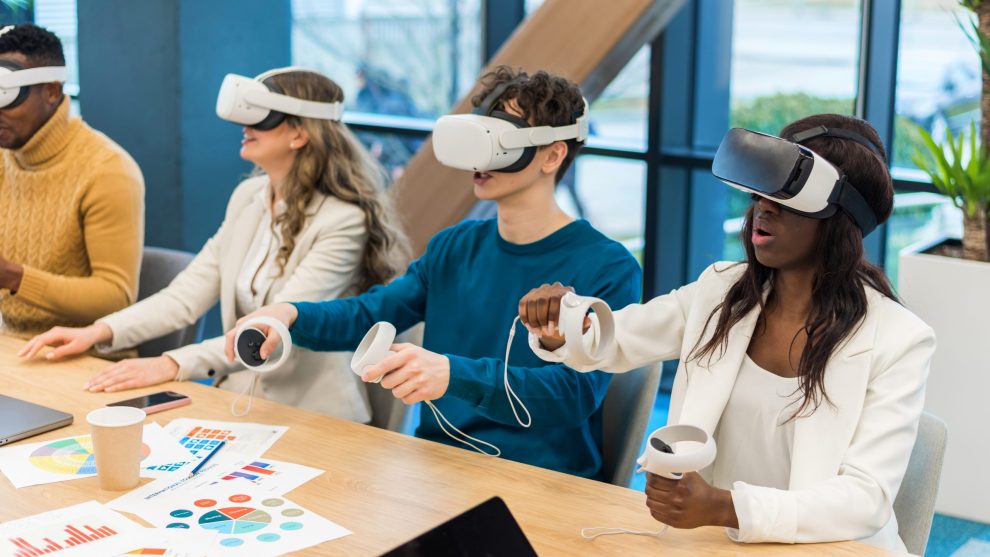Gone are the days of static training manuals and monotonous video conferences. Virtual Reality (VR) and Augmented Reality (AR) are fueling a dynamic shift in the landscape of skills development and remote collaboration. These innovative immersive technologies are blurring lines between physical and digital environments, offering groundbreaking solutions for businesses and professionals.
Unlocking Human Potential with Immersive Skills Training
VR and AR are profoundly enhancing workplace training across industries. By simulating real-world environments and situations, they provide captivating yet low-risk opportunities for employees to build expertise. Studies reveal a 70% boost in learning outcomes with immersive training methods compared to traditional approaches.
Key Benefits of Immersive Skills Training:
- Realistic Practice Settings: Trainees can apply skills in intricately modeled virtual environments, from hospital wards to jet engine assembly lines.
- Safe Skill-Building: Employees can make mistakes and take risks within simulations without real-world repercussions.
- Repeatable Scenarios: Difficult situations like fires, complex surgeries, or extreme weather can be practiced repeatedly for mastery.
- Personalized Learning: Training programs adapt to individual needs, ensuring efficient skill development.
- Accessibility & Scalability: Anyone can train together through VR/AR regardless of geography or workplace limitations.
These advantages translate to confident, work-ready employees. Imagine firefighters prepared for any blaze, pilots ready for challenging conditions, or doctors able to perform delicate surgery without hesitation.
Supercharging Collaboration with Immersive Workspaces
VR and AR are also revolutionizing collaboration by enabling teams to interact seamlessly in shared virtual workspaces. This allows smooth communication, decision-making, and innovation regardless of physical location.
Benefits of Immersive Remote Collaboration:
- Virtual Face-to-Face Connection: Meetings in VR replicate in-person engagement better than video conferencing.
- Intuitive Tools & Interfaces: Interactive features like 3D models and collective whiteboards enhance discussion and ideation.
- Spatial Visualization: Complex data and designs can be manipulated together for improved analysis.
- Enhanced Productivity & Innovation: Immersive collaboration drives better outcomes, new ideas, and workplace satisfaction.
By facilitating seamless teamwork regardless of geography, immersive technologies enable organizations to access global talent pools and empower employees through flexible work arrangements.
Implementing Immersive Technologies: Key Considerations
To successfully leverage VR/AR for transformational training and collaboration, focus on four key implementation factors:
1. Curate Engaging Content
Well-designed immersive content keeps users engaged and drives adoption. Invest in skilled creators to develop customized VR/AR experiences tailored to your learners and teams.
2. Choose Compatible Platforms
Select hardware and software solutions aligned to your infrastructure, capabilities, and budget. Prioritize ease-of-use, data security, and seamless integration.
3. Support User Adoption
Smoothly transitioning workforce skills and habits to immersive technology is crucial. Provide training, address concerns, and showcase benefits to ensure user buy-in.
4. Continuously Optimize
Leverage data and feedback to continuously refine implementation. Pilot test new features and measure impact to maximize value over time. Remain flexible as technology rapidly advances.
The Future of Work is Immersive
VR and AR are profoundly disrupting workplace training and collaboration today, with increasing adoption across industries. As costs decrease and capabilities expand, immersive technology will become standard in skills development, communication, and innovation.
Organizations that strategically implement VR/AR give their workforce the digital capabilities needed to thrive. This unlocks immense opportunities for productivity, employee satisfaction, and business growth. The future is immersive – it’s time to embrace the exciting possibilities of extended reality!
















Add Comment